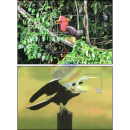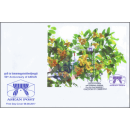Description
Opr. (5x2 with gutter); A = perf. K 13; B = imperforated
Souvenir Sheet-FDC(I), Date of issue: 24.04.2019
Picture descriptions:
dro-drw) Pictures of the Tonle Sap
drw) Cormorant drying the plumage
2658 B 6000 R multicolored drw
Souvenir Sheet issue with MiNo. 2657B
Souvenir Sheet 346B (120 mm x 80 mm) dry
Quantity Souvenir Sheet: 200 pieces
Quantity Souvenir Sheet FDC(I): 100 pieces
Printer: Vietnam Printing
Designer: Cambodia Post
Conservation Status:
Here as a Souvenir Sheet FDC (Version I) with first day special postmark
Issue Notice:
- Souvenir Sheet 346B was sold only together with Souvenir Sheet 345A for 39.900 R (10 US$)
- The Tonle Sap Lake in Cambodia is the largest lake in Southeast Asia and one of the richest inland water resources. From the north, the lake is fed by several tributaries. In the south, the lake is connected to the Tonle Sap River, which forms the inflow or outflow in seasonal change and further south in Phnom Penh flows into the Mekong.Every year in June there is a unique natural phenomenon worldwide.
- Due to monsoon rains and meltwater from the Himalayas, the Mekong River produces up to four times more water at this time than during the dry months. Since Cambodia is a largely flat and flat country, the waters of the Mekong River pushes into the Tonle Sap River, which then changes its direction of flow. At the end, the masses of water fill the basin of the lake. During the dry season it has a surface of about 3,000 km ², until it grows to about 25,000 km ² and is up to five times as deep. The peak of the flood will be reached in September. At this time, nearly one third of Cambodia's agricultural land is covered by water. Only in November, when the Mekong again less water, the river changes direction again, and the water of the lake flows slowly.
- Lake Tonle Sap, together with the Tonle Sap, Mekong and Bassac rivers, form a unique ecosystem that not only allows the species richness (around 200 plant and 150 fish species, rare waterfowl, numerous water snakes, Siam crocodiles, etc.) in the water and in the surrounding area but was also crucial to the development of people living in the area and their culture.
- The historical kingdoms of the Khmer with their center in Angkor, which is only a few kilometers north of the lake, would probably not have been created without the wealth of water and the accompanying abundance of food.










